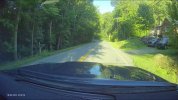HDR has become what amounts to marketing term and corporations appear to apply the terms WDR or HDR rather loosely now but the fact is they are not the same thing.
HDR TV is a display technology that has nothing whatsoever to do with the subject at hand which is image capture, so why drag it into the discussion?
You can read all about HDR TV in an excellent basic article on the subject on C/net, titled, "HDR for photography vs. HDR for TVs: What's the difference? The article not only explains the technology but also correctly identifies photographic HDR capture as a multiple exposure technique. Also see: "Photo HDR isn't TV HDR" - "One of the most important things to know about HDR TVs is that TV HDR is not the same as photo HDR".
This began as a discussion specific to the techniques used in dash cams. Jokiin stated that WDR and HDR are the same technology in dash cams but that is not quite accurate despite the misinformation floating around.
So far we have only seen two methods employed in dash cams for dynamic range management - WDR and HDR. HDR is a photography concept while WDR is a term that first appeared in the CCTV industry.
At its heart, WDR functionality
in dash cams is nothing more than a modification of the contrast curve to boost the shadow details in high contrast scenarios. It does little or nothing to control blown out highlight details in the upper tonal range and has been known to occasionally compromise footage in other situations.
Actual HDR in dash cams has employed synchronized dual imaging. One of the best examples we've seen was in the first iteration of the Mobius 2 which provided spectacular HDR results. Unfortunately, the technique compromised other IQ aspects such as detail in in object in motion that had a lot of texture which led to HDR being abandoned in the M2.
One of the problems with multi-frame HDR in dash cams appears to be the limited processing power of the SoC chipsets used in dash cams. What might work easily for even a primitive still camera is no quite so easy for a $100 SoC video camera like the A119. Still, if Viofo can make this work we are in store for some exciting things. Of course, we are still waiting for more information regarding how exactly they are approaching HDR. And you know, considering this absurd debate I am at least gratified to see that Viofo indeed actually uses the term "HDR".

BTW, here is an early example of the Mobius 2 split 60/30 fps dual frame HDR at work. It produced spectacular results, not only in the extreme highlights but in dramatically opening up the shadows. Here is it compared to the SG9665GC to give you an idea of just what can be accomplished. In all fairness to Street Guardian this example is from the period before the AE tables were finally addressed in new firmware after about a year and a half after the first complaints about the problem started rolling in so the dynamic range problem seen here is exaggerated. Recent GC firmware is dramatically improved over what you see here so keep that in mind. It is presented here merely to illustrate the potential of true HDR vs WDR (which was enabled on the GC, btw.) This is the only synchronized comparison I have between two cameras from the time when the M2 still employed the dual frame HDR technique in its firmware.
View attachment 33667
View attachment 33668



